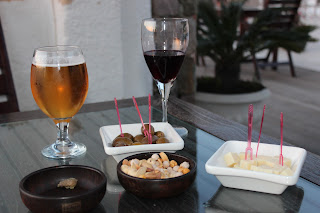The Kervansaray Lara Hotel. Notice the giant flag. They're everywhere on holidays.
Antalya, is another amazing city. As with everywhere else in Turkey, this was a quick flight from Ankara-just 46 minutes to get there and 38 minutes to get back. We left Friday afternoon at 4:15 and returned Monday at 7:00 PM. In the past, we have generally left for vacations after interacting with parents and kids for an entire school year, and just liked to "chill out" and do very little but relax and read books. Since we've been here, most of our trips have been tourist activities, trying to cram in as many sights and experiences as possible. Antalya was a little different, as we were in an all inclusive resort, and spent Saturday and Monday on the beach or by the pool. I read two novels and started a third (and drank a lot of their free booze)
The pool water was very cool but refreshing, but the sea water was very comfortable.
We left the resort on Sunday, taking a shuttle to the old town center. On a restaurant street just before the old bazaar area, we looked up to see umbrellas---lots of umbrellas.
We spent quite a bit of times in the shops, one of which was in a 500 year old hamam, or bath house. The oldest multi-domed mosque is at the base of this "fluted" minaret, over 800 years old.
In the bazaar area they were very ornate in the way they displayed their spices.
We just kept walking downhill, stopping and talking to shop owners along the way. After a sharp left turn, we were at a small harbor. As we were walking past, two guys invited us (for 45 TL each) to go for a quick boat tour. A total of eight of us, a couple from Latvia, four Turks, and and Peggy and I, were out on the water for about an hour.
The water was so very blue near all of the cliffs.
As our resort was all sandy beaches, we were surprised by the cliffs and lack of beach in the old town 18 kilometers to the west of the resort. We saw many "sunning" platforms with hundreds of steps from old hotels down to the water. There were more tour boats in the water on this afternoon than anything else, but we did see a few enjoying the day fishing or sailing.
The water was just beautiful and wonderful with small waves and a nice temperature. The air temperature was in the mid 90's when we left on Monday. We enjoyed being served and pampered again. The evening shows were nice, and on Friday night after the entertainment they even had fireworks. Unlike many Mexico vacations, this water was very clean, no smells, soft waves, and full of Europeans! It was very relaxing and a nice break before the final push with kids. Our last day with students is June 18, so it's now less than a month away!
























































